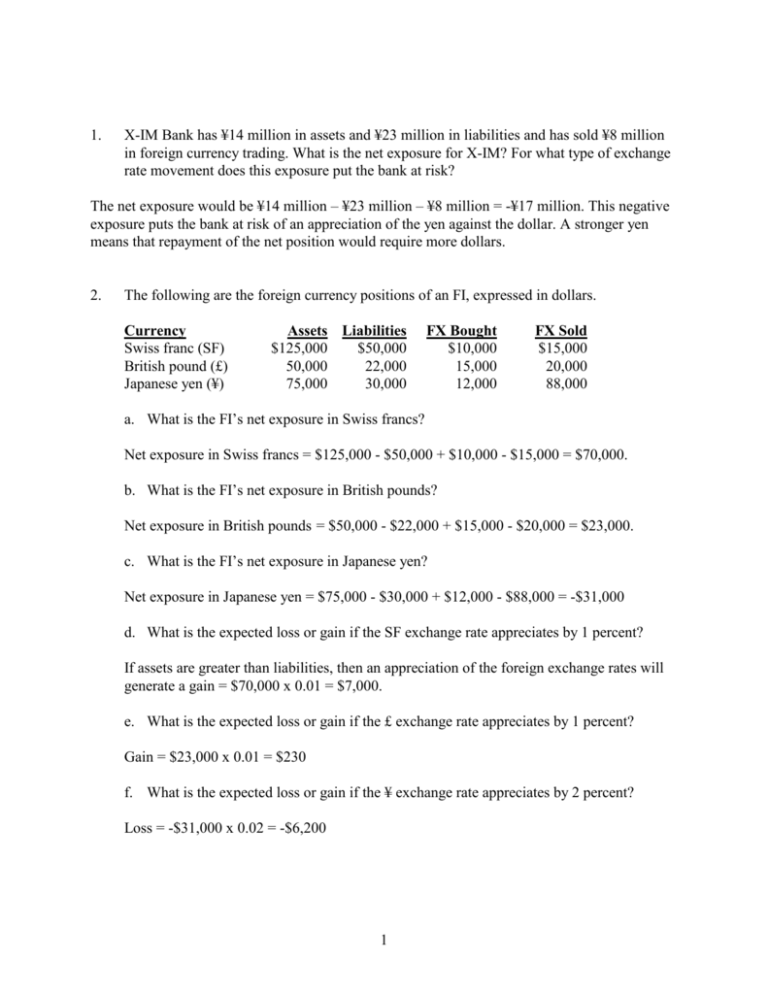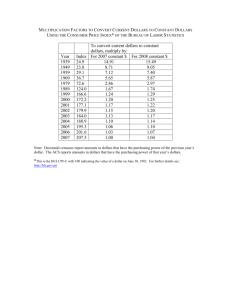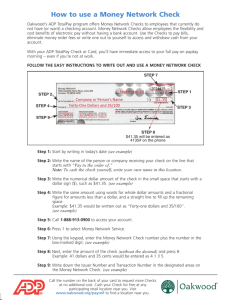Chapter Fifteen
advertisement

1. X-IM Bank has ¥14 million in assets and ¥23 million in liabilities and has sold ¥8 million in foreign currency trading. What is the net exposure for X-IM? For what type of exchange rate movement does this exposure put the bank at risk? The net exposure would be ¥14 million – ¥23 million – ¥8 million = -¥17 million. This negative exposure puts the bank at risk of an appreciation of the yen against the dollar. A stronger yen means that repayment of the net position would require more dollars. 2. The following are the foreign currency positions of an FI, expressed in dollars. Currency Swiss franc (SF) British pound (£) Japanese yen (¥) Assets Liabilities $125,000 $50,000 50,000 22,000 75,000 30,000 FX Bought $10,000 15,000 12,000 FX Sold $15,000 20,000 88,000 a. What is the FI’s net exposure in Swiss francs? Net exposure in Swiss francs = $125,000 - $50,000 + $10,000 - $15,000 = $70,000. b. What is the FI’s net exposure in British pounds? Net exposure in British pounds = $50,000 - $22,000 + $15,000 - $20,000 = $23,000. c. What is the FI’s net exposure in Japanese yen? Net exposure in Japanese yen = $75,000 - $30,000 + $12,000 - $88,000 = -$31,000 d. What is the expected loss or gain if the SF exchange rate appreciates by 1 percent? If assets are greater than liabilities, then an appreciation of the foreign exchange rates will generate a gain = $70,000 x 0.01 = $7,000. e. What is the expected loss or gain if the £ exchange rate appreciates by 1 percent? Gain = $23,000 x 0.01 = $230 f. What is the expected loss or gain if the ¥ exchange rate appreciates by 2 percent? Loss = -$31,000 x 0.02 = -$6,200 1 3. City Bank issued $200 million of one-year CDs in the U.S. at a rate of 6.50 percent. It invested part of this money, $100 million, in the purchase of a one-year bond issued by a U.S. firm at an annual rate of 7 percent. The remaining $100 million was invested in a oneyear Brazilian government bond paying an annual interest rate of 8 percent. The exchange rate at the time of the transaction was Brazilian real 1/$. a. What will be the net return on this $200 million investment in bonds if the exchange rate between the Brazilian real and the U.S. dollar remains the same? Cost of funds = 0.065 x $200 million = $13 million Return on U.S. loan = 0.07 x $100 million = $ 7,000,000 Return on Brazilian bond = (.08 x Real 100 m)/1.00 = $ 8,000,000 Total interest earned = $15,000,000 Net return on investment = $15 million - $13 million/$200 million = 1.00 percent. b. What will be the net return on this $200 million investment if the exchange rate changes to real 1.20/$? Cost of funds = 0.065 x $200 million = $13,000,000 Return on U.S. loan = 0.07 x $100 million Return on Brazilian bond = (0.08 x Real 100m)/1.20 Total interest earned = $ 7,000,000 = $ 6,666,667 = $13,666,667 Net return on investment = $13,666,667 - $13,000,000/$200,000,000 = 0.67 percent. Consideration should be given to the fact that the Brazilian bond was for Real100 million. Thus, at maturity the bond will be paid back for Real100 million/1.20 = $83,333,333.33. Therefore, the strengthening dollar will have caused a loss in capital ($16,666,666.67) that far exceeds the interest earned on the Brazilian bond. c. What will be the net return on this $200 million investment if the exchange rate changes to real 0.80/$? Cost of funds = 0.065 x $200 million Return on U.S. loan = 0.07 x $100 million Return on Brazilian bond = (.08 x Real 100m)/0.80 Total interest earned = $13,000,000 = $ 7,000,000 = $10,000,000 = $17,000,000 Net return on investment = $17,000,000 - $13,000,000/$200,000,000 = 2.00 percent. Consideration should be given to the fact that the Brazilian bond was for Real100 million. Thus, at maturity the bond will be paid back for Real100 million/0.80 = $125,000,000. 2 Therefore, the strengthening Real will have caused a gain in capital of $25,000,000 in addition to the interest earned on the Brazilian bond. 4. Sun Bank USA purchased a 16 million one-year Swiss franc loan that pays 12 percent interest annually. The spot rate for Swiss francs is SF1.60/$. Sun Bank has funded this loan by accepting a British pound (£)-denominated deposit for the equivalent amount and maturity at an annual rate of 10 percent. The current spot rate of the British pound is $1.60/£. a. What is the net interest income earned in dollars on this one-year transaction if the spot rates at the end of the year are SF1.70/$ and $1.85/£? . Loan amount = SF16 million/1.60 = $10 million Deposit amount = $10m/1.60 = £6,250,000 Interest income at the end of the year = SF16m x 0.12 = SF1.92/1.70 = $1,129,411.77 Interest expense at the end of the year = £6,250,000 x 0.10 = £625,000 x 1.85 = $1,156,250 Net interest income = $1,129,411.77 - $1,156,250.00 = -$26,838.23 b. What should be the £ to US$ spot rate in order for the bank to earn a net interest margin of 4 percent? A net interest margin of 4 percent would imply $10,000,000 x 0.04 = $400,000. The net cost of deposits should be $1,129,411.77 - 400,000 = $729,411.77. Pound rate = $729,411.77/625,000 = $1.1671/£. Thus, the pound should be selling at $1.1671/£ in order for the bank to earn 4 percent. c. Does your answer to part (b) imply that the dollar should appreciate or depreciate against the pound? The dollar should appreciate against the pound. It takes fewer dollars to buy one pound. d. What is the total effect on net interest income and principal of this transaction given the end-of-year spot rates in part (a)? Interest income and loan principal at year-end = (€16m x 1.12)/1.70 = $10,541,176.47 Interest expense and deposit principal at year-end = (£6.25m x 1.10) x 1.85 = $12,718,750 Total income = $10,541,176.47 - $12,718,750.00 = -$2,177,573.53 5. Suppose that the current spot exchange rate of U.S. dollars for Australian dollars, SUS$/A$, is .7590 (i.e., 0.759 dollars, or 75.9 cents, can be received for 1 Australian dollar). The price of Australian-produced goods increases by 5 percent (i.e., inflation in Australia, IPA, is 5 percent), and the U.S. price index increases by 3 percent (i.e., inflation in the United States, IPUS, is 3 percent). Calculate the new spot exchange rate of U.S. dollars for Australian dollars that should result from the differences in inflation rates. 3 According to PPP, the 5 percent rise in the price of Australian goods relative to the 3 percent rise in the price of U.S. goods results in a depreciation of the Australian dollar (by 2 percent). Specifically, the exchange rate of Australian dollars to U.S. dollars should fall, so that: iUS - iA SUS$/A$/SUS$/A$ Plugging in the inflation and exchange rates, we get: .03 or: and: - SUS$/A$/SUS$/A$ SUS$/A$/ .759 SUS$/A$/ .759 SUS$/A$ = -(.02) × .759 = -.01518 Thus, it costs 1.518 cents less to receive an Australian dollar (or it costs 15.98 cents (75.9 cents depreciates in value by 2 percent against the U.S. dollar as a result of its higher inflation rate. 4







